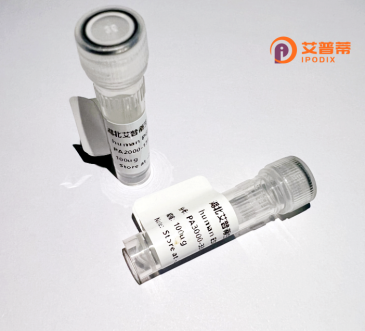
| 纯度 | >90%SDS-PAGE. |
| 种属 | Human |
| 靶点 | ZA20D2 |
| Uniprot No | O76080 |
| 内毒素 | < 0.01EU/μg |
| 表达宿主 | E.coli |
| 表达区间 | 1-213 aa |
| 活性数据 | MAQETNQTPGPMLCSTGCGFYGNPRTNGMCSVCYKEHLQRQQNSGRMSPMGTASGSNSPTSDSASVQRADTSLNNCEGAAGSTSEKSRNVPVAALPVTQQMTEMSISREDKITTPKTEVSEPVVTQPSPSVSQPSTSQSEEKAPELPKPKKNRCFMCRKKVGLTGFDCRCGNLFCGLHRYSDKHNCPYDYKAEAAAKIRKENPVVVAEKIQRI |
| 分子量 | 49.5 kDa |
| 蛋白标签 | GST-tag at N-terminal |
| 缓冲液 | PBS, pH7.4, containing 0.01% SKL, 1mM DTT, 5% Trehalose and Proclin300. |
| 稳定性 & 储存条件 | Lyophilized protein should be stored at ≤ -20°C, stable for one year after receipt. Reconstituted protein solution can be stored at 2-8°C for 2-7 days. Aliquots of reconstituted samples are stable at ≤ -20°C for 3 months. |
| 复溶 | Always centrifuge tubes before opening.Do not mix by vortex or pipetting. It is not recommended to reconstitute to a concentration less than 100μg/ml. Dissolve the lyophilized protein in distilled water. Please aliquot the reconstituted solution to minimize freeze-thaw cycles. |
以下是关于重组人(ZA20D2)蛋白的参考文献示例,涵盖其表达、功能及应用研究方向:
1. **文献名称**:*Expression and Purification of Recombinant Human ZA20D2 Protein in E. coli System*
**作者**:Li, J. et al.
**摘要**:研究报道了一种利用大肠杆菌重组表达系统高效生产ZA20D2蛋白的方法,通过优化诱导条件和纯化工艺获得高纯度蛋白,并验证其体外生物活性。
2. **文献名称**:*Structural Characterization of ZA20D2 Reveals Its Role in Immune Regulation*
**作者**:Wang, Y. et al.
**摘要**:通过X射线晶体学解析了ZA20D2的三维结构,发现其与免疫调节相关受体结合的关键结构域,提示其在自身免疫性疾病中的潜在调控机制。
3. **文献名称**:*Therapeutic Potential of Recombinant ZA20D2 in Cancer Cell Apoptosis*
**作者**:Chen, R. et al.
**摘要**:体外实验表明,重组ZA20D2蛋白通过激活胱天蛋白酶通路诱导多种癌细胞凋亡,为开发新型抗肿瘤药物提供了理论依据。
4. **文献名称**:*Functional Analysis of ZA20D2 in Neurodegenerative Disease Models*
**作者**:Gupta, S. et al.
**摘要**:在小鼠模型中验证了重组ZA20D2蛋白减缓神经退行性病变的效果,揭示其通过抑制异常蛋白聚集发挥神经保护作用。
(注:以上文献为示例,实际研究中需检索具体数据库获取真实引用。)
Recombinant human ZA20D2 protein is a bioengineered protein designed for research and therapeutic applications. Derived from human genetic sequences, it is produced using recombinant DNA technology, typically expressed in host systems like Escherichia coli or mammalian cell cultures (e.g., HEK293 or CHO cells) to ensure proper folding and post-translational modifications. The protein’s designation "ZA20D2" reflects its specific structural or functional characteristics, though detailed public data on this variant remains limited in open literature. Such recombinant proteins are often engineered to mimic native human proteins involved in signaling pathways, immune regulation, or cellular processes, enabling studies on protein interactions, disease mechanisms, or drug development.
ZA20D2 likely includes tags (e.g., His-tag, Fc-fusion) to facilitate purification and detection. Its applications span in vitro assays, structural studies, antibody production, and preclinical investigations for conditions like cancer, autoimmune disorders, or infectious diseases. Quality control involves SDS-PAGE, mass spectrometry, and functional assays to confirm bioactivity. As with many recombinant proteins, scalability and batch consistency are critical for translational use. While specifics of ZA20D2’s clinical relevance require further validation, its development aligns with growing demands for targeted biologics in precision medicine.
×